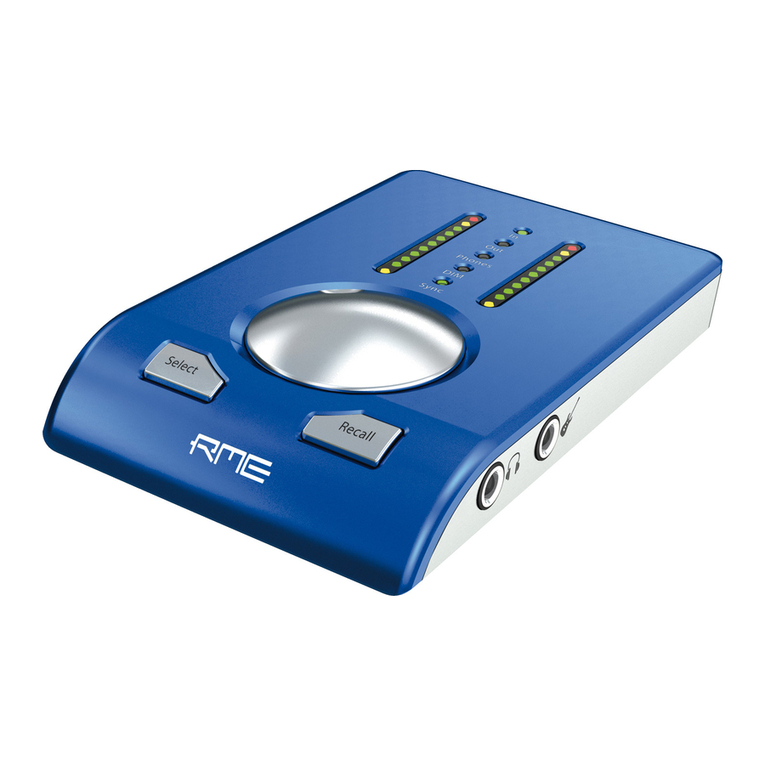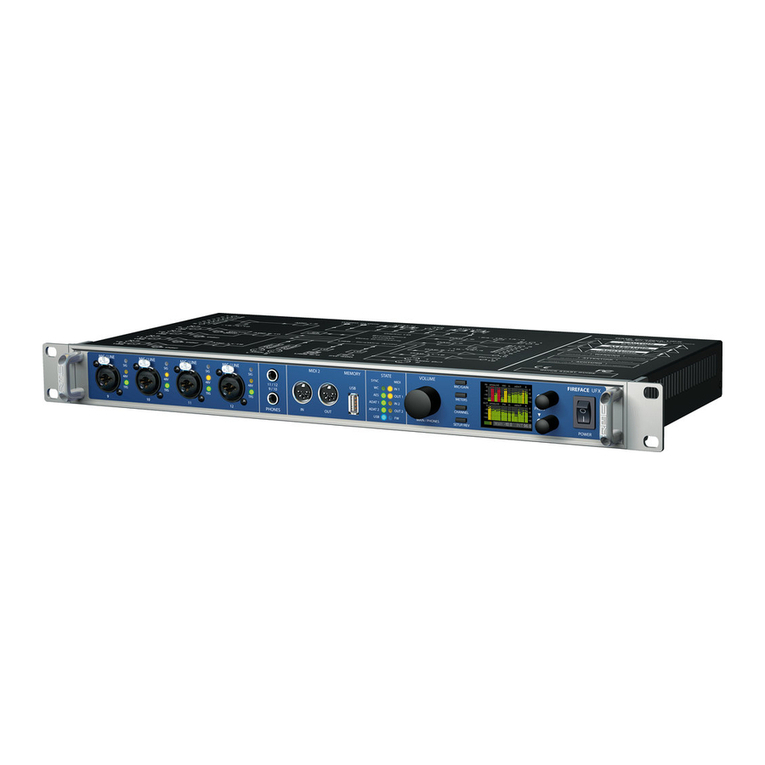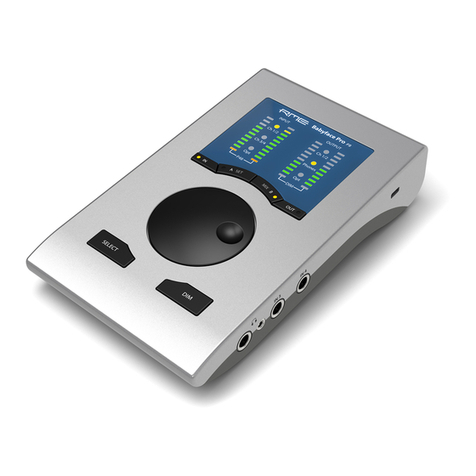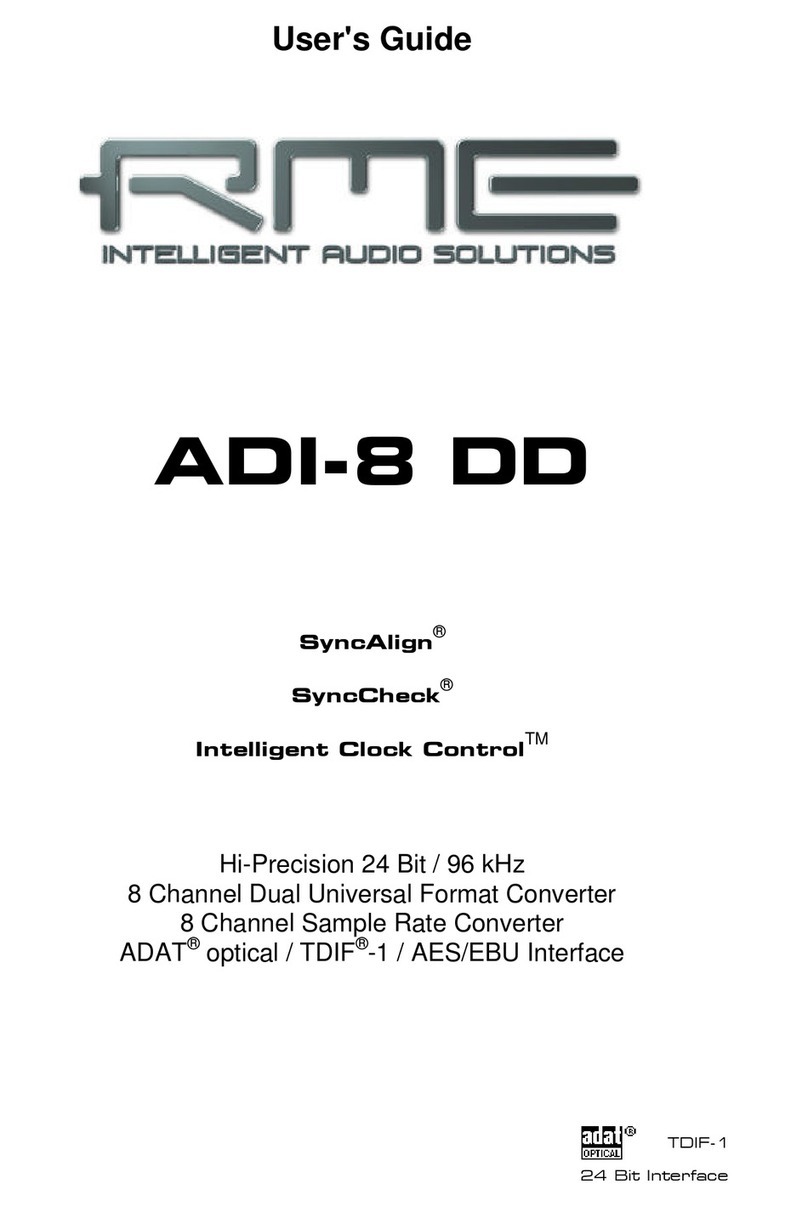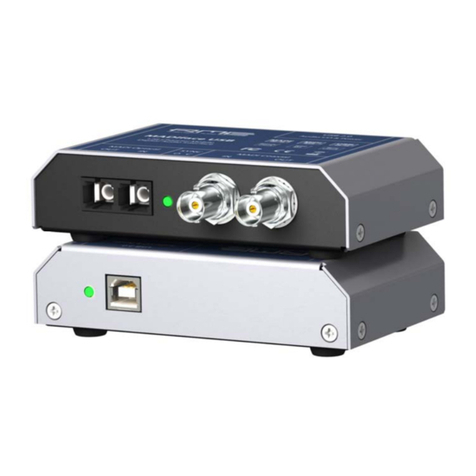RME Audio ADI-648 User manual

User's Guide
ADI-648
Multichannel Audio Digital Interface
SyncAlignTM
SyncCheckTM
Intelligent Clock ControlTM
SteadyClockTM
Hi-Precision 24 Bit / 192 kHz
64 Channel MADI / ADAT Converter
16 x 16 Matrix Router
MIDI embedded in MADI
Firmware 2.5 or up
MADI
24 Bit Interface

2 User's Guide ADI-648 © RME
Important Safety Instructions ...........................................................................3
1 Introduction ........................................................................................................5
2 Package Contents..............................................................................................5
3 Brief Description and Characteristics..............................................................5
4 Technical Specifications
4.1 Inputs...............................................................................................................6
4.2 Outputs............................................................................................................7
5 First Usage
5.1 Quick Start ......................................................................................................8
5.2 Firmware.........................................................................................................8
5.3 Operating the ADI-648....................................................................................9
6 The MADI to ADAT Converter
6.1 General .........................................................................................................10
6.2 Inputs.............................................................................................................10
6.3 Input State Display........................................................................................10
6.4 Outputs ADAT Optical...................................................................................11
7 The ADAT to MADI Converter
7.1 General .........................................................................................................12
7.2 Inputs.............................................................................................................12
7.3 Input State Display........................................................................................12
7.4 Outputs MADI................................................................................................13
8 Clock Section
8.1 Clock Configuration.......................................................................................13
8.2 Lock and SyncCheck....................................................................................14
8.3 Word Clock Input and Output........................................................................15
9 Word Clock
9.1 Operation and Technical Background ..........................................................16
9.2 Cabling and Termination...............................................................................17
10 MIDI
10.1 Transmission of MIDI..................................................................................18
10.2 Remote Controlling the ADI-648 ................................................................18
10.3 Remote Control Software...........................................................................19
11 Special Modes
11.1 MADI to MADI Converter............................................................................21
11.2 ADAT Patchbay and Splitter.......................................................................21
11.3 MADI Coaxial/Optical Converter ................................................................21
11.4 MADI Merger ..............................................................................................22
11.5 MADInet......................................................................................................22
12 Technical Background
12.1 DS – Double Speed....................................................................................23
12.2 QS – Quad Speed......................................................................................23
12.3 MADI Basics...............................................................................................24
12.4 SteadyClock ...............................................................................................25
13 Controls and Connectors................................................................................26
14 Block Diagram..................................................................................................27
15 MIDI Implementation Chart
15.1 Basic SysEx Format...................................................................................28
15.2 Message Types..........................................................................................28
15.3 MADI Input State – Redundancy Mode......................................................28
16 Warranty............................................................................................................31
17 Appendix...........................................................................................................31

User's Guide ADI-648 © RME 3
Important Safety Instructions
ATTENTION! Do not open chassis – risk of electric shock
The unit has non-isolated live parts inside. No user serviceable parts inside.
Refer service to qualified service personnel.
Mains
• The device must be earthed – never use it without proper grounding
• Do not use defective power cords
• Operation of the device is limited to the manual
• Use same type of fuse only
To reduce the risk of fire or electric shock do not expose this device to rain or
moisture. Prevent moisture and water from entering the device. Never leave
a pot with liquid on top of the device. Do not use this product near water, i. e.
swimming pool, bathtub or wet basement. Danger of condensation inside –
don't turn on before the device has reached room temperature.
Installation
Surface may become hot during operation – ensure sufficient ventilation.
Avoid direct sun light and do not place it near other sources of heat, like ra-
diators or stoves. When mounting in a rack, leave some space between this
device and others for ventilation.
Unauthorized servicing/repair voids warranty. Only use accessories
specified by the manufacturer.
Read the manual completely. It includes all information necessary
to use and operate this device.

4 User's Guide ADI-648 © RME

User's Guide ADI-648 © RME 5
1. Introduction
With the ADI-648 you have an incredibly versatile digital interface to your supply. What at first
looks like a simple MADI to ADAT format converter, turns out to be an extremely flexible prob-
lem solver at a closer look. From small project studios to broadcast and television, this Ad-
vanced Digital Interface is the perfect tool for many tasks.
As a consequent continuation of RME's world-wide successful ADI-8 series, the 648 also con-
tains elaborate technology and the latest integrated circuits. In a few words: The ADI-648 is a
uniquely powerful and high-quality device, which will excite you even after many years of opera-
tion.
2. Package Contents
Please check that your ADI-648 package contains each of the following:
•ADI-648
•Manual
•Power chord
3. Brief Description and Characteristics
The ADI-648 consists of two 64-channel digital format converters in reference quality, in a stan-
dard 19" box with 1 unit height. The compact device has numerous extraordinary features like
Intelligent Clock Control (ICC), SyncCheck®, SyncAlign®, Bitclock PLL, SteadyClock, patchbay
functionality, and a 16x16 Matrix router.
All of the ADI-648 I/Os support 192 kHz/24 bit. As ADAT optical is restricted to 48kHz, in DS
mode (Double Speed) two channels are being used for the transmission of one channel's data.
The Sample Split algorithm used is compatible to S/MUX and Double Wire, and also imple-
mented in RME's Hammerfall DSP and FireWire devices. Thus the ADI-648 also serves as an
ideal MADI frontend for these interfaces, on both Mac and PC.
The format conversion between MADI and ADAT operates in both directions at the same time.
LEDs of different colours show the present state of incoming and outgoing signals and of the
internal processing in a clear way.
The unique Intelligent Clock Control (ICC) allows for a flexible use with internal clock (44.1, 48,
88.2 and 96 kHz), external word clock or the digital input signals. These options are intelligently
coupled in a way typical for RME, and easy to apply thanks to a clear and easily understand-
able display of the Lock and Sync states.
Futhermore the unique 16 x 16 Matrix Router allows to use the ADI-648 as patchbay and split-
ter. All 128 input channels, MADI and ADAT, can be routed to all 128 outputs – even within the
same format.

6 User's Guide ADI-648 © RME
4. Technical Specifications
•Power supply: Internal switching PSU, 100 - 240 V AC, 20 Watt
•Typical power consumption: 9 Watt
•Dimensions including rack ears (WxHxD): 483 x 44 x 242 mm (19" x 1.73" x 9.5")
•Dimensions without rack ears/handles (WxHxD): 436 x 44 x 235 mm (17.2" x 1.73" x 9.3")
•Weight: 2 kg ( 4.4 lbs)
•Temperature range: +5° up to +50° Celsius (41° F up to 122°F)
•Relative humidity: < 75%, non condensing
4.1 Inputs
MADI
•Coaxial via BNC, 75 Ohm, according to AES10-1991
•High-sensitivity input stage (< 0.2 Vpp)
•Optical via FDDI duplex SC connector
•62.5/125 and 50/125 compatible
•Accepts 56 channel and 64 channel mode, and 96k Frame
•Single Wire: up to 64 channels 24 bit 48 kHz
•Double Wire: up to 32 channels 24 bit 96 kHz
•Quad Wire: up to 16 channels 24 bit 192 kHz
•Lock range: 28 kHz – 54 kHz
•Jitter when synced to input signal: < 1 ns
ADAT Optical
•8 x TOSLINK, according to Alesis specification
•Standard: 64 channels 24 bit, up to 48 kHz
•S/MUX: 8 x 4 channels 24 bit / 96 kHz
•S/MUX4: 8 x 2 channels 24 bit / 192 kHz
•Bitclock PLL ensures perfect synchronisation even in varispeed operation
•Lock range: 31 kHz – 56 kHz
•Jitter when synced to input signal: < 1 ns
Word Clock
•BNC, not terminated (10 kOhm)
•Automatic Double Speed detection and internal conversion to Single Speed
•PLL for low jitter synchronisation even in varispeed operation
•Transformer coupled, galvanically isolated input
•Not affected by DC-offsets within the network
•Signal Adaptation Circuit: signal refresh through auto-center and hysteresis
•Overvoltage protection
•Level range: 1.0 Vpp – 5.6 Vpp
•Lock range: 27 kHz – 112 kHz
•Jitter when synced to input signal: < 1 ns
•Switch for internal termination 75 Ohm

User's Guide ADI-648 © RME 7
MIDI
•16 channels MIDI
•5-pin DIN jack
•Optocoupled, ground-free input
•Invisible transmission via User bit of channel 56 (up to 48 kHz)
•Invisible transmission via User bit of channel 28 (96k Frame)
4.2 Outputs
MADI
•Coaxial via BNC, 75 Ohm, according to AES10-1991
•Output voltage 600 mVpp
•Cable length: up to 100 m
•Optical via FDDI duplex SC connector
•62.5/125 and 50/125 compatible
•Cable length: up to 2,000 m
•Generates 56 channel and 64 channel mode, and 96k Frame
•Single Wire: up to 64 channels 24 bit 48 kHz
•Double Wire / 96K Frame: up to 32 channels 24 bit 96 kHz
•Quad Wire: up to 16 channels 24 bit 192 kHz
ADAT Optical
•8 x TOSLINK
•Standard: 8 x 8 channels 24 bit, up to 48 kHz
•S/MUX: 8 x 4 channels 24 bit / 96 kHz
•S/MUX4: 8 x 2 channels 24 bit / 192 kHz
Word Clock
•BNC
•Max. output voltage: 5 Vpp
•Output voltage @ 75 Ohm: 4.0 Vpp
•Impedance: 10 Ohms
•Frequency range: 27 kHz – 56 kHz
MIDI
•16 channels MIDI
•5-pin DIN jack
4.2 Digital
•Clocks: Internal, ADAT In, MADI In, Word Clock In
•Low jitter design: < 1 ns in PLL mode, all inputs
•Internal clock: 800 ps jitter, random spread spectrum
•Jitter suppression of external clocks: > 30 dB (2.4 kHz)
•PLL ensures zero dropout, even at more than 100 ns jitter
•Additional Bitclock PLL for trouble-free varispeed ADAT operation
•Supported sample rates: 32 / 44.1 / 48 / 64 / 88.2 / 96 / 176.4 / 192 kHz

8 User's Guide ADI-648 © RME
5. First Usage
5.1 Quick Start
The user interface of the ADI-648 is characterized by a clearly structured architecture and an
unambiguous labelling of the front and rear sides. The device can thus be used easily without a
manual, because numerous LEDs show the state of the device and of all incoming and outgoing
signals in a strictly logical way. However, we don't want to hold you back from reading this man-
ual, as it includes a lot of important and useful information.
The ADI-648 remembers all settings before switching off and sets them automatically when
switching on the next time.
When being switched on for the first time, the ADI-648 comes up in a default mode, which
should be appropriate for most applications. The device is in slave mode and gets its reference
clock directly out of the MADI input signal. The Matrix Router is deactivated.
A quick guide for operation and functionality of the ADI-648 can be found on the next page.
For transmission of the digital signals into a computer we recommend RME's interface cards of
the Hammerfall®DSP series, especially the HDSP MADI. These high quality digital audio cards
are available with drivers for all common operating systems, and have the highest reputation
world-wide.
5.2 Firmware
The ADI-648's main part has been realized using programmable logic. By exchanging a little
component called EPROM, both function and behaviour of the unit can be changed at any time.
At the time of writing this manual, the unit is shipped with firmware 2.5. This firmware is not
compatible to older units, which do not have the REMOTE key. The firmware version is dis-
played after power on by the AUDIO LEDs for about one second.
Since firmware version 2.5 not only ADAT input 8, but also the current Matrix configuration in-
fluences the output mode. If MADI output group 8 is assigned to any input, the device generates
64 channel format. This is also true when MATRIX STATE is set to OFF. As this channel as-
signment is factory default, all ADI-648 with firmware 2.5 will generate 64 channel mode as
default mode. To activate the 56 channel format for the MADI output, the MADI output group 8
has to be set to Mute, and no signal must be present at ADAT input 8.

User's Guide ADI-648 © RME 9
5.3 Operating the ADI-648
Join us for a small 'tour de ADI', starting on the left side at the MADI to ADAT Converter. Con-
figuration starts with choosing the input, BNC or optical. The state of the input signal is dis-
played by 14 LEDs. Shown are active input, automatic input selection, receiver state, Sync, 56
or 64 channel format, 48k Frame or 96k Frame, and audio data within 8-channel groups. The
Sync LED shows the synchronicity between input signal and external/internal clock, or between
the active inputs.
The ADAT to MADI
Converter shows the
Sync state for each of
the 8 inputs via 8
LEDs. Again 8 LEDs
display incoming
audio data per 8-
channel group.
By using the 96k FRAME key, the MADI output is switched into Double Speed mode. This mode
is active when the '96k Frame' LED is lit. In case the WCK LED is lit, the word clock output no
longer provides 44.1/48 kHz, but 88.2/96 kHz. However many devices operate in Single Speed
only, and distribute – as known from Double Wire – 96 kHz data on two channels. In this case
the ADI-648 operates correctly even without changing to 96k Frame mode, because Double
Wire will be converted 1:1 to ADAT (S/MUX).
RME's intelligent clock control (ICC) offers extensive and professional means. To start with, the
clock source can be set to Internal (crystal), External (BNC word clock) and Input, while Input
lets you select between ADAT and MADI. The INT(ernal) clock rates are 44.1 and 48kHz. Lock
state is displayed by the state of the input LEDs (flashing or constantly lit).
The ADI-648 can be remote controlled by MIDI commands. The key REMOTE is used to select
the source of the MIDI commands, and also the destination for the ADI-648's request replies.
The normal MIDI ports or the MADI input and output can be chosen. The current REMOTE se-
lection does not have any influence on the basic conversion of MIDI to MADI and vice versa.
Normally all 64 MADI channels will be routed to the according ADAT outputs, and all ADAT
inputs to the 64-channel MADI output (optical and coaxial output operate in parallel).
The 16 x 16 Matrix Router can be activated via the STATE key, and allows to change this rout-
ing. First choose an output by pressing the Output Select key, then use the Input Select key to
select the desired input. An input can be assigned to as many outputs as present (splitting), but
an output can not be assigned to more than one input (digital mixing). Routing within the same
format is also allowed. This way ADAT inputs can be routed directly to ADAT outputs, without
the need of a MADI loopback cabling. So all attached devices can send signals to each other
without the need to rearrange the cabling between them.
When stepping through all inputs: the input is muted when no LED is lit. To reset the Matrix
Router to the factory default (routing as if de-activated), press the INPUT and OUTPUT
SELECT keys at the same time.

10 User's Guide ADI-648 © RME
6. The MADI to ADAT Converter
6.1 General
This part of the ADI-648 converts MADI to ADAT optical. MADI offers 64 channels of 24 bit au-
dio at up to 48 kHz sample rate, 32 channels at up to 96 kHz, or 16 channels at up to 192 kHz.
Transmission happens over a single line, either coaxial (BNC) or fiber optic (network). In both
cases the cable length can be more than 100 meters.
The 64 MADI channels are transferred to 8 ADAT optical outputs (TOSLINK). Furthermore, the
ADI-648 contains an easy-configurable 8-channel 16x16 Matrix Router. Any of the outputs,
which are divided into 8-channel blocks, can be fed from any 8-channel input block, both on the
ADAT and the MADI side. With this, there is not only free routing within the MADI to ADAT con-
version, but also splitting and routing within the same format.
6.2 Inputs
Both MADI inputs are located on the rear of the ADI-648.
The BNC input's ground-free design is built according to AES10-1991. The input's impedance is
75 Ohm. It will operate error-free from about 180 mVpp.
The optical input uses a FDDI (ISO/IEC 9413-3) compatible optical module, according to
AES10-1991. More information can be found in chapter 12.2, MADI Basics.
The ADI-648 includes automatic input selection. In case the current input signal fails, the unit
switches to the other input immediately. This mode, called redundancy mode, offers improved
safety against errors on the transmission line. Switching the inputs is done in about one second.
The ADI-648 displays redundancy operation by a blinking LED of the original input, while the
input LED of the currently active input will be lit constantly.
6.3 Input State Display
The state of the MADI input is displayed by different LEDs. The ERROR LED is directly coupled
with the MADI-Receiver, and informs the user reliably about the quality of the input signal. The
LED will light up red, as soon as there is any error, be it a carrier voltage which is too low, inva-
lid data or any other error which prevents the receiver from accepting the input signal.
If a valid input signal is applied, SyncCheck is active automatically. If the MADI input is not cho-
sen as clock source, SyncCheck takes the chosen clock (Internal, External, ADAT) as reference
and compares it with the MADI input clock. In case no synchronous operation is detected the
SYNC LED will start blinking.
Audio data present in the input channels is signalled by an AUDIO LED. As the ADI-648 is
based on ADAT ports and therefore operates in 8-channel blocks, an AUDIO LED will show
audio data from 8 channels simultaneously. The green LED is lit as soon as one of the channels
of an 8-channel block contains audio data, means is no longer digital zero.

User's Guide ADI-648 © RME 11
6.4 Outputs ADAT Optical
The ADI-648 provides 8 outputs in ADAT optical format. They are fully compatible to all ADAT
optical inputs. A usual TOSLINK cable is sufficient for connection.
With the Matrix Router de-activated, all MADI channels are copied to the 8-channel ADAT for-
mat in a logical order:
MADI In 1-8 9-16 17-24 25-32 33-40 41-48 49-56 57-64
ADAT Out 1 2 3 4 5 6 7 8
If a MADI signal in Double Wire format (standard frame) is present at the input, technically no
special processing is activated, because the output signals will be in Sample Split format
(S/MUX) right away.
In 96K FRAME mode, the ADI-648 automatically converts Double Speed data to Sample Split
(S/MUX). The data of one MADI channel will be processed and routed to two ADAT channels
according to the following table:
MADI In 1 2 3 4 5 6 7 8
DS Signal
Port 1/2
1 3/4
1 5/6
1 7/8
1 1/2
2 3/4
2 5/6
2 7/8
2
MADI In 9 10 11 12 13 14 15 16
DS Signal
Port 1/2
3 3/4
3 5/6
3 7/8
3 1/2
4 3/4
4 5/6
4 7/8
4
MADI In 17 18 19 20 21 22 23 24
DS Signal
Port 1/2
5 3/4
5 5/6
5 7/8
5 1/2
6 3/4
6 5/6
6 7/8
6
MADI In 25 26 27 28 29 30 31 32
DS Signal
Port 1/2
7 3/4
7 5/6
7 7/8
7 1/2
8 3/4
8 5/6
8 7/8
8
As the device internally always operates in Sample Split mode, the Matrix won't change its func-
tionality in Double Wire, Quad Wire (Sample Split = Single Speed) and 96K Frame (Double
Speed). In both cases the number of channels is reduced to 28/32 or 14/16. At the same time
the Matrix Router no longer operates in 8-channel, but in 4-channel or 2-channel blocks.

12 User's Guide ADI-648 © RME
7. The ADAT to MADI Converter
7.1 General
This part of the ADI-648 converts ADAT optical to MADI. ADAT optical carries 8 channels of 24
bit audio at up to 48 kHz sample rate, 4 channels at up to 96 kHz, and 2 channels at up to 192
kHz. Transmission is done via a single optical line (TOSLINK). The length of the optical cable is
limited to about 10 m.
Because the Sample Split (S/MUX, S/MUX4) format doesn't contain a coding, the ADI-648 can-
not distinguish it from normal (44.1/48 kHz) material. Whether the MADI output is supposed to
work in 96K Frame mode has to be set explicitly by the user.
The inputs can be used in any combination, e. g. it is sufficient to connect an input signal only to
input 3. In slave mode, this input is automatically being used as clock source. If more than one
signal is present, the one furthest left is being used as clock source, i. e. the active input with
the lowest number.
The 8 ADAT optical inputs are transferred to a 64-channel MADI output. Furthermore, the ADI-
648 contains an easy-configurable 8-channel 16x16 Matrix Router. Any of the outputs, which
are divided into 8-channel blocks, can be fed from any 8-channel input block, both on the ADAT
and the MADI side. With this, there is not only free routing within the ADAT to MADI conversion,
but also splitting and routing within the same format.
7.2 Inputs
The ADAT optical inputs of the ADI-648 are fully compatible with all ADAT optical outputs.
ADAT input 8 is used to switch the MADI output format from 56-channel to 64-channel mode.
When ADAT input 8 does not receive a valid input signal, the ADI-648 generates a 56-channel
MADI signal. When feeding a valid input signal, a 64-channel MADI signal will be generated.
This rule is also true when 96K Frame mode is active. Then 28 or 32 channels will be available.
Since firmware version 2.5 the current Matrix configuration also influences the output mode. If
MADI output group 8 is assigned to any input, the device generates 64 channel format. This is
also true when MATRIX STATE is set to OFF. As this channel assignment is factory default, all
ADI-648 will generate 64 channel mode as default mode. To activate the 56 channel format for
the MADI output, the MADI output group 8 has to be set to Mute, and no signal must be present
at ADAT input 8.
7.3 Input State Display
The input state is being displayed by means of 16 LEDs. A missing or invalid input signal is
indicated by flashing of the SYNC LED. When using multiple inputs in clock mode ADAT
INPUT, the input with the lowest number is being used as clock source. In case ADAT is not
chosen as clock reference, SyncCheck takes the chosen clock (internal, external, MADI) as
reference and compares it to the clocks of the inputs. Non synchronous inputs will be indicated
by flashing of the corresponding SYNC LED. A missing or invalid input signal will be displayed
by blinking of the ADAT INPUT CLOCK LED.
Audio data present in the input channels are signalled by an AUDIO LED per input. As the ADI-
648 operates in 8-channel blocks, an AUDIO LED will show audio data from 8 channels simul-
taneously. The green LED is lit as soon as one of the channels of an 8-channel block contains
audio data, means is no longer digital zero.

User's Guide ADI-648 © RME 13
7.4 Outputs MADI
At the rear side of the ADI-648 there are two MADI outputs.
The BNC output is built according to AES10-1991. The output's impedance is 75 Ohms. The
output voltage will be 600 mVpp when terminated with 75 Ohms.
The optical output uses a FDDI (ISO/IEC 9413-3) compatible optical module, according to
AES10-1991. More information can be found in chapter 11.2, MADI Basics.
With the Matrix Router de-activated, all ADAT channels are copied to the MADI format in a logi-
cal order:
ADAT In 1 2 3 4 5 6 7 8
MADI Out 1-8 9-16 17-24 25-32 33-40 41-48 49-56 57-64
When activating the 96k Frame mode, channel distribution changes as follows:
ADAT In 1 2 3 4 5 6 7 8
MADI Out 1-4 5-8 9-12 13-16 17-20 21-24 25-28 29-32
As the device internally always operates in Sample Split mode, the Matrix won't change its func-
tionality in Double Wire, Quad Wire (Sample Split = Single Speed) and 96K Frame (Double
Speed). In both cases the number of channels is reduced to 28/32 or 14/16. At the same time
the Matrix Router no longer operates in 8-channel, but in 4-channel or 2-channel blocks.
8. Clock Section
8.1 Clock Configuration
The unique ICC technology (Intelligent Clock Control) allows for a flexible use of both converter
units with internal clock (44.1 and 48 kHz, 88.2 and 96 kHz in DS mode), external word clock or
the digital input signals. All options are intelligently coupled and easily applicable and under-
standable, thanks to a clear display of the corresponding lock state.
As clock source, INTERNAL (crystal), EXTERNAL (BNC word clock) and INPUT (the digital
input signal ADAT/MADI) can be chosen. If the clock signal is present, the corresponding LED
will light constantly. If no signal is present, the LED will flash.
The ADI-648 can extract its reference clock directly from the MADI signal. In most cases an
additional word clock will not be necessary.
INPUT
As displayed on the front panel, the CLOCK SOURCE for the INPUT setting can be the ADAT
or MADI input. A missing or invalid clock source signal is indicated by flashing of the corre-
sponding LED.
EXT.
With EXTERNAL, the ADI-648's word clock input is used as clock reference. The LED will flash,
if the word clock is missing or unusable.

14 User's Guide ADI-648 © RME
INT.
For INTERNAL, 44.1 kHz or 48 kHz sampling rate is available. Note: the key 96k FRAME does
only affect the format of the MADI output, not channel distribution or sample rate of the ADAT
outputs.
For the INTERNAL clock setting it is mandatory that the clock rate of the sources is syn-
chronous to the ADI-648. Therefore the external device has to be synchronized to the ADI-
648's word clock out or ADAT/MADI out.
The ADI-648 thus has to be master, all devices connected to it slave. In order to avoid clicks
and drop outs due to faulty or missing synchronicity, a special process called SyncCheck com-
pares the incoming data and the ADI-648's internal clock. SYNC is indicated by flashing (error)
or constantly lit (OK) LED.
8.2 Lock, SyncCheck and SyncAlign
Digital signals consist of a carrier and the data. If a digital signal is applied to an input, the re-
ceiver has to synchronize to the carrier clock in order to read the data correctly. To achieve this,
the receiver uses a PLL (Phase Locked Loop). As soon as the receiver meets the exact fre-
quency of the incoming signal, it is locked. This Lock state remains even with small changes of
the frequency, because the PLL tracks the receiver's frequency.
If an ADAT or MADI signal is applied to the ADI-648, the corresponding input LED starts flash-
ing. The ADI-648 indicates LOCK, i. e. a valid input signal (in case the signal is in sync, the LED
will be lit constantly, see below).
Unfortunately, LOCK does not necessarily mean that the received signal is correct with respect
to the clock which processes the read out of the embedded data. Example [1]: The ADI-648 is
set to 44.1 kHz INT(ernal), and a mixing desk having an ADAT output is connected to input
ADAT1. The INPUT LED will show LOCK immediately, but the mixing desk's clock is usually
generated internally (clock mode master), thus slightly higher or lower than the ADI-648's inter-
nal sample rate. Result: When reading out the data, there will frequently be read errors that
cause clicks and drop outs.
Also when using multiple inputs, a simple LOCK is not sufficient. The problem described above
can be solved elegantly by setting the ADI-648 from INT to INPUT (its internal clock will then be
the clock delivered by the mixing desk). But in case another asynchronous source is connected,
there will again be a slight difference in the sample rate, and therefore clicks and drop outs.
In order to display those problems optically at the device, the ADI-648 contains SyncCheck®. It
checks all clocks used for synchronicity. If they are not synchronous to each other (i. e. abso-
lutely identical), the SYNC LED of the asynchronous input flashes. If in total sync, the LED will
be lit constantly. In example 1 it would have been obvious at once that the SYNC ADAT1 LED
was flashing.
In practice, SyncCheck allows for a quick overview of the correct configuration of all digital de-
vices. So one of the most difficult and error-prone topics of the digital studio world finally be-
comes easy to handle.

User's Guide ADI-648 © RME 15
8.3 Word Clock Input and Output
SteadyClock guarantees an excellent performance in all clock modes. Its highly efficient jitter
suppression refreshes and cleans up any clock signal, and provides it as reference clock at the
BNC output (see section 12.4).
Input
The ADI-648's transformer isolated word clock input is active when EXT is chosen in the clock
section. The signal at the BNC input can be single or double speed, the ADI-648 automatically
adapts to it. As soon as a valid signal is detected, the EXT LED is constantly lit, otherwise it is
flashing.
Thanks to RME's Signal Adaptation Circuit, the word clock input still works correctly even with
heavily mis-shaped, dc-prone, too small or overshoot-prone signals. Thanks to automatic signal
centering, 300 mV (0.3V) input level is sufficient in principle. An additional hysteresis reduces
sensitivity to 1.0 V, so that over- and undershoots and high frequency disturbances don't cause
a wrong trigger.
The ADI-648's word clock input is shipped as
high impedance type (not terminated). A push
switch allows to activate internal termination
(75 Ohms). The switch is found on the back
between the BNC jacks. Use a small pencil or
similar and carefully push the blue switch so
that it snaps into its lock position. Another push
will release it again and de-activate the termi-
nation.
Output
The word clock output is constantly active, providing the current sample frequency as word
clock signal. In master mode (Int.), the word clock will be fixed to 44.1 kHz or 48 kHz. In any
other case the sample rate is identical to the one present at the currently chosen clock input.
When the current word clock source fails, the last valid sample rate will be held automatically.
The word clock signal received by the HDSP MADI can be distributed to other devices by using
the word clock output. With this the usual T-adapter can be avoided, and the HDSP MADI oper-
ates as Signal Refresher. This kind of operation is highly recommended, because
•Input and output are phase-locked and in phase (0°) to each other
•SteadyClock removes nearly all jitter from the input signal
•the exceptional input (1 Vpp sensitivity instead of the usual 2.5 Vpp, dc cut, Signal Adapta-
tion Circuit) plus SteadyClock guarantee a secure function also with most critical word
clock signals.
The word clock output usually operates in Single Speed mode, as do all ADAT and TDIF
ports.
In S/MUX or Double Speed mode, the word clock output will therefore be no higher than 48
kHz. In case a Double Speed word clock is needed (88.2 or 96 kHz), press the key 96K FRAME
several times, until the LED WCK is lit.
Thanks to a low impedance, but short circuit proof output, the ADI-648 delivers 4 Vpp to 75
Ohms. For wrong termination with 2 x 75 Ohms (37.5 Ohms), there are still 3.3 Vpp at the out-
put.

16 User's Guide ADI-648 © RME
9. Word Clock
9.1 Operation and Technical Background
In the analog domain one can connect any device to another device, a synchronization is not
necessary. Digital audio is different. It uses a clock, the sample frequency. The signal can only
be processed and transmitted when all participating devices share the same clock. If not, the
signal will suffer from wrong samples, distortion, crackle sounds and drop outs.
AES/EBU, SPDIF, ADAT and MADI are self-clocking, an additional word clock connection in
principle isn't necessary. But when using more than one device simultaneously problems are
likely to happen. For example any self-clocking will not work in a loop cabling, when there is no
'master' (main clock) inside the loop. Additionally the clock of all participating devices has to be
synchronous. This is often impossible with devices limited to playback, for example CD players,
as these have no SPDIF input, thus can't use the self clocking technique as clock reference.
In a digital studio synchronisation is maintained by connecting all devices to a central sync
source. For example the mixing desk works as master and sends a reference signal, the word
clock, to all other devices. Of course this will only work as long as all other devices are
equipped with a word clock or sync input, thus being able to work as slave (some professional
CD players indeed have a word clock input). Then all devices get the same clock and will work
in every possible combination with each other.
Remember that a digital system can only have one master! If the ADI-648’s clock mode is
set to 'Master', all other devices must be set to ‘Slave’.
But word clock is not only the 'great problem solver', it also has some disadvantages. The word
clock is based on a fraction of the really needed clock. For example SPDIF: 44.1 kHz word
clock (a simple square wave signal) has to be multiplied by 256 inside the device using a spe-
cial PLL (to about 11.2 MHz). This signal then replaces the one from the quartz crystal. Big
disadvantage: because of the high multiplication factor the reconstructed clock will have great
deviations called jitter. The jitter of a word clock is much higher as when using a quartz based
clock.
The end of these problems should have been the so called Superclock, which uses 256 times
the word clock frequency. This equals the internal quartz frequency, so no PLL for multiplying is
needed and the clock can be used directly. But reality was different, the Superclock proved to
be much more critical than word clock. A square wave signal of 11 MHz distributed to several
devices - this simply means to fight with high frequency technology. Reflections, cable quality,
capacitive loads - at 44.1 kHz these factors may be ignored, at 11 MHz they are the end of the
clock network. Additionally it was found that a PLL not only generates jitter, but also rejects
disturbances. The slow PLL works like a filter for induced and modulated frequencies above
several kHz. As the Superclock is used without any filtering such a kind of jitter and noise sup-
pression is missing.
The actual end of these problems is offered by the SteadyClock technology of the ADI-648.
Combining the advantages of modern and fastest digital technology with analog filter tech-
niques, re-gaining a low jitter clock signal of 22 MHz from a slow word clock of 44.1 kHz is no
problem anymore. Additionally, jitter on the input signal is highly rejected, so that even in real
world usage the re-gained clock signal is of highest quality.

User's Guide ADI-648 © RME 17
9.2 Cabling and Termination
Word clock signals are usually distributed in the form of a network, split with BNC T-adapters
and terminated with resistors. We recommend using off-the-shelf BNC cables to connect all
devices, as this type of cable is used for most computer networks. You will find all the neces-
sary components (T-adapters, terminators, cables) in most electronics and/or computer stores.
The latter usually carries 50 Ohm components. The 75 Ohm components used for word clock
are part of video technology (RG59).
Ideally, the word clock signal is a 5 Volt square wave with the frequency of the sample rate, of
which the harmonics go up to far above 500 kHz. To avoid voltage loss and reflections, both the
cable itself and the terminating resistor at the end of the chain should have an impedance of 75
Ohm. If the voltage is too low, synchronization will fail. High frequency reflection effects can
cause both jitter and sync failure.
Unfortunately there are still many devices on the market, even newer digital mixing consoles,
which are supplied with a word clock output that can only be called unsatisfactory. If the output
breaks down to 3 Volts when terminating with 75 Ohms, you have to take into account that a
device, of which the input only works from 2.8 Volts and above, does not function correctly al-
ready after 3 meter cable length. So it is not astonishing that because of the higher voltage,
word clock networks are in some cases more stable and reliable if cables are not terminated at
all.
Ideally all outputs of word clock delivering devices are designed as low impedance types, but all
word clock inputs as high impedance types, in order to not weaken the signal on the chain. But
there are also negative examples, when the 75 Ohms are built into the device and cannot be
switched off. In this case the network load is often 2 x 75 Ohms, and the user is forced to buy a
special word clock distributor. Note that such a device is generally recommended for larger
studios.
The ADI-648's word clock input can be high-impedance or terminated internally, ensuring maxi-
mum flexibility. If termination is necessary (e.g. because ADI-648 is the last device in the chain),
push the switch at the back (see chapter 8.3).
In case the ADI-648 resides within a chain of devices receiving word clock, plug a T-adapter
into its BNC input jack, and the cable supplying the word clock signal to one end of the adapter.
Connect the free end to the next device in the chain via a further BNC cable. The last device in
the chain should be terminated using another T-adapter and a 75 Ohm resistor (available as
short BNC plug). Of course devices with internal termination do not need T-adaptor and termi-
nator plug.
Due to the outstanding SteadyClock technology of the ADI-648, we recommend not to pass
the input signal via T-adapter, but to use the ADI-648's word clock output instead. Thanks
to SteadyClock, the input signal will both be freed from jitter and - in case of loss or drop out
– be held at the last valid frequency.

18 User's Guide ADI-648 © RME
10. MIDI
10.1 MIDI Transmission
MADI allows for a transmission of 64 audio channels over long distances with a single line –
perfect. But what about MIDI? Be it remote control commands or sequencer data, in practice
only a single MADI line will not suffice. Therefore the ADI-648 also has a MIDI I/O port. The
data at the MIDI input are being included into the MADI signal invisibly, and can be collected at
the MIDI output of another ADI-648, or a Hammerfall DSP MADI, at the other end of the MADI
line.
Technically every single MADI channel includes several additional bits, containing various in-
formation (Channel Status). RME use the usually unused User Bit of channel 56 (channel 28 in
96k Frame mode), to transmit MIDI data invisibly within MADI, ensuring full compatibility.
The block diagram shows
the basic MIDI operation.
The MIDI input signal is
added to the MADI output
signal. The MIDI data found
in the MADI input signal will
be available at the MIDI
output. This functionality, a
bi-directional MIDI/MADI
converter, is always avail-
able, and not affected by
the REMOTE key.
The MIDI input signal will never be transferred directly from MADI to MADI, no matter how the
matrix router is set up. A MIDI cable connecting MIDI output and MIDI input of the ADI-648, will
realize a direct pass-through of MIDI, from MADI input to MADI output.
10.2 Remote Controlling the ADI-648
The ADI-648 can be completely remote controlled via MIDI. The CPU shown above reacts on
specific commands. Furthermore, upon request the CPU will report the complete device status.
This includes all controls and LEDs on the front plate. Each ADI-648 can be programmed with
its own ID, providing a separated remote control of multiple devices via a single MIDI channel. A
description of the MIDI implementation is found in section 15.
The key REMOTE is used to select the source of the MIDI commands, and also the destination
for the ADI-648's request replies. A push on REMOTE toggles between MIDI port, MADI port
and Off. The latter is a safety function to prevent any setup-change by any MIDI signal. In the
picture above, the MIDI commands reach the CPU via the MIDI input, and the CPU's feedback
on commands is only available at the MIDI output.
To remote control an ADI-648 from a Hammerfall DSP via MADI, REMOTE has to be set to
MADI. As can be seen in the block diagram on the next page, this setup provides a complete
data path for MIDI in both directions.

User's Guide ADI-648 © RME 19
10.3 Remote Control Software
The Windows and Mac software MIDI Remote can be downloaded for free from the RME web-
site. It can use any existing MIDI port within the system to perform remote control and status
requests of all ADI-648 via a simple mouse click. Most appealing is the combination with a
HDSP MADI (PCI card), offering a direct control of the ADI-648 via MADI. The remote control
software then uses a virtual MIDI port of the card (port 3), which directly sends and receives
MIDI data via MADI.
The block diagram shows
the signal flow in a MADI
remote controlled system.
MIDI commands from a
software on PC or Mac
travel via MADI to the MIDI
Out of the ADI-648. At the
same time they reach the
648's CPU. The MIDI sig-
nals of external devices
travel via MIDI In and MADI
Out back to the software,
together with the request
responses of the CPU.
The software can be foundon the RME website, section Downloads, MIDI Remote.
MIDI Remote's user interface offers lots of advanced features for an easy and intuitive every-
day usage. Two views are available: a front-panel style surface, and a full matrix display. The
following screenshot shows the software in operation and in both views.
Software MIDI Remote in front panel view mode

20 User's Guide ADI-648 © RME
Software MIDI Remote in matrix view mode
Brief description of Windows Software ADI-648 MIDI Remote
File – Save Setup
All settings can be stored in a file, and reloaded at any time. This is especially useful to quickly
load different routings, or to access different ADI-648 with different IDs.
Options – Start/Stop MIDI I/O
Start / Stop of the MIDI communication. The current state is displayed in the title bar, showing
chosen ID, online / no response / offline.
Options – MIDI Device Select
Opens a dialog to select the used MIDI input and output port.
Options – Select Device ID
Opens a dialog box to select a device ID. Choosing 'All', the current device ID of the unit is ig-
nored. The setting 'All' is not allowed when using more than one ADI-648.
Options – Program Device ID
Opens a dialog to program a device ID into the ADI-648. Note: programming is fast and not
confirmed. Attention: Programming is only possible when only one ADI-648 is connected via
MIDI!
Other manuals for ADI-648
1
Table of contents
Other RME Audio Accessories manuals
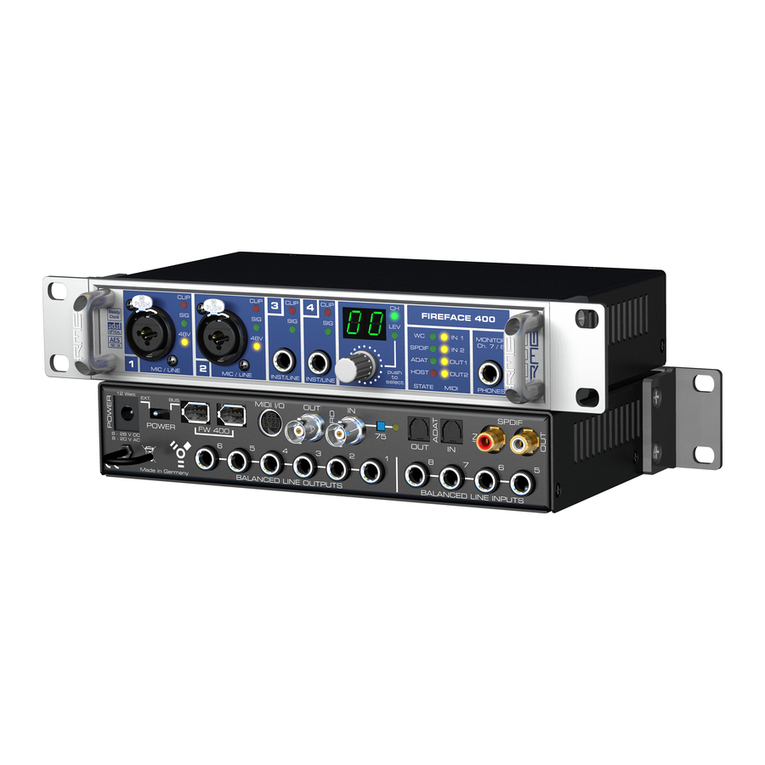
RME Audio
RME Audio Fireface 400 User manual
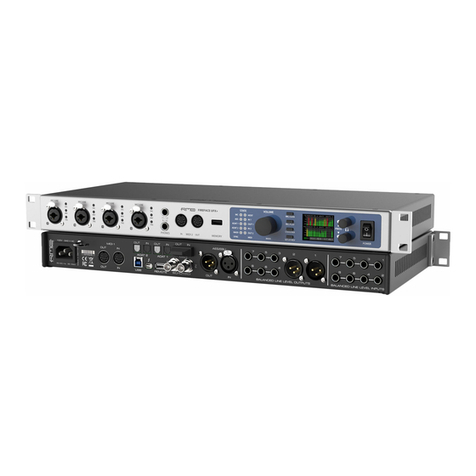
RME Audio
RME Audio Fireface UFX+ User manual

RME Audio
RME Audio Fireface UCX User manual
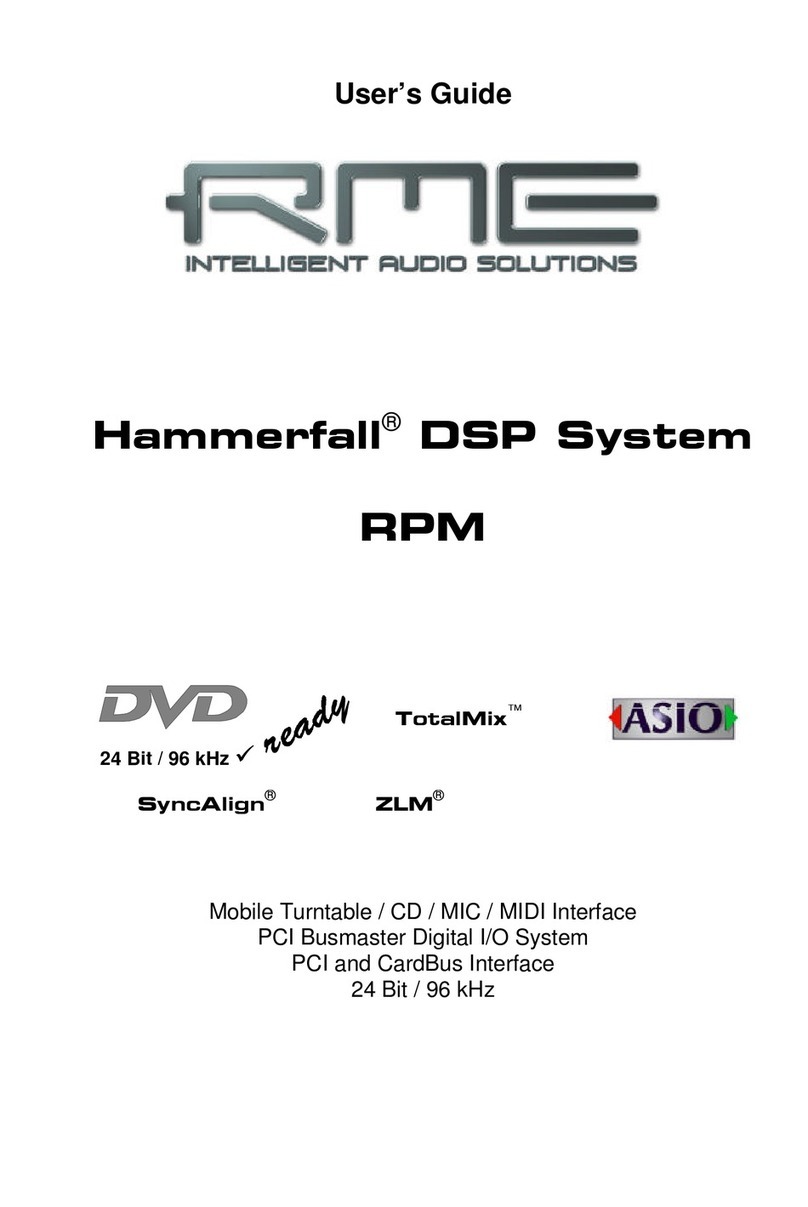
RME Audio
RME Audio Hammerfall RPM User manual
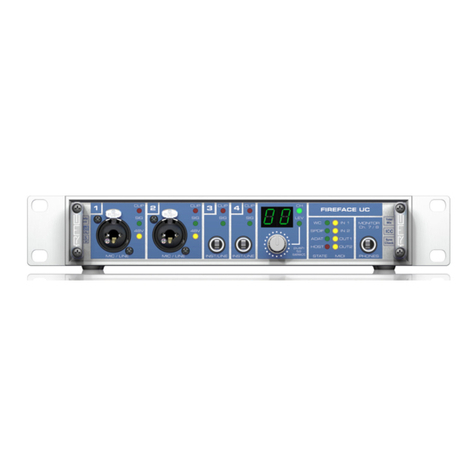
RME Audio
RME Audio Fireface UC User manual
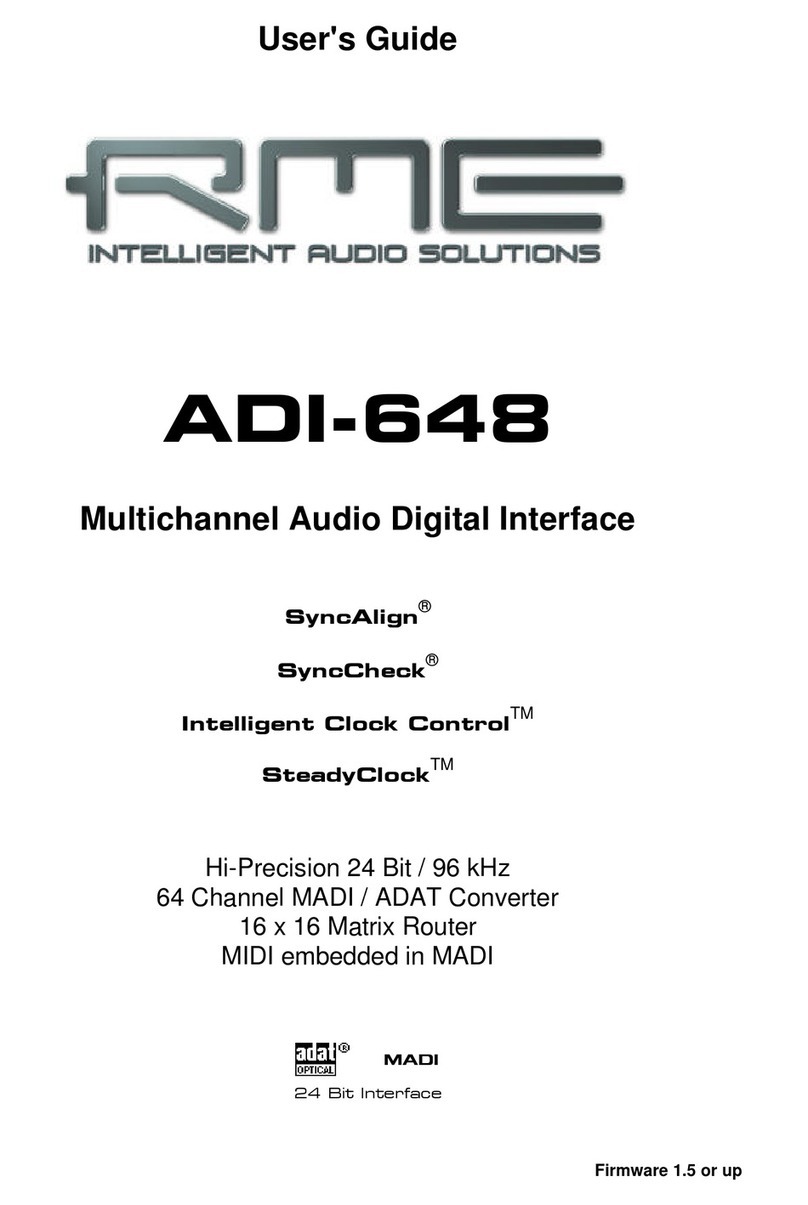
RME Audio
RME Audio ADI-648 User manual
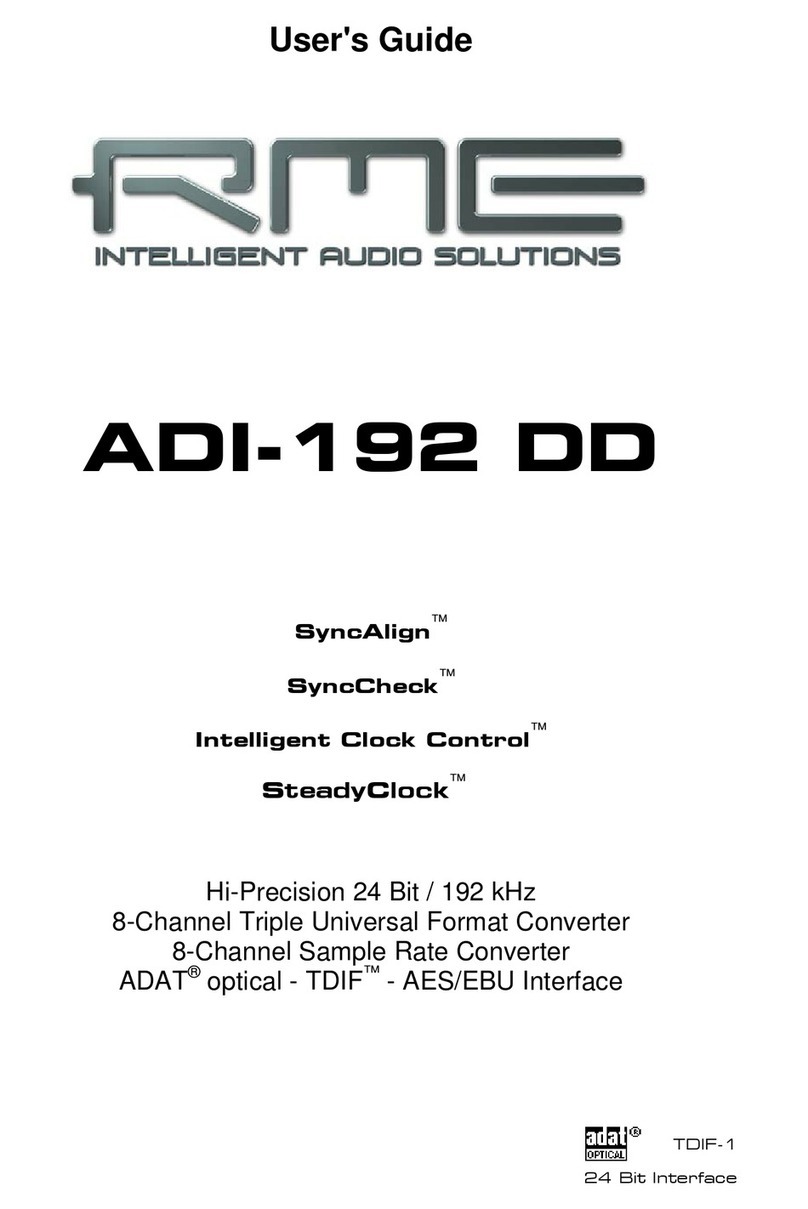
RME Audio
RME Audio ADI-192 DD User manual
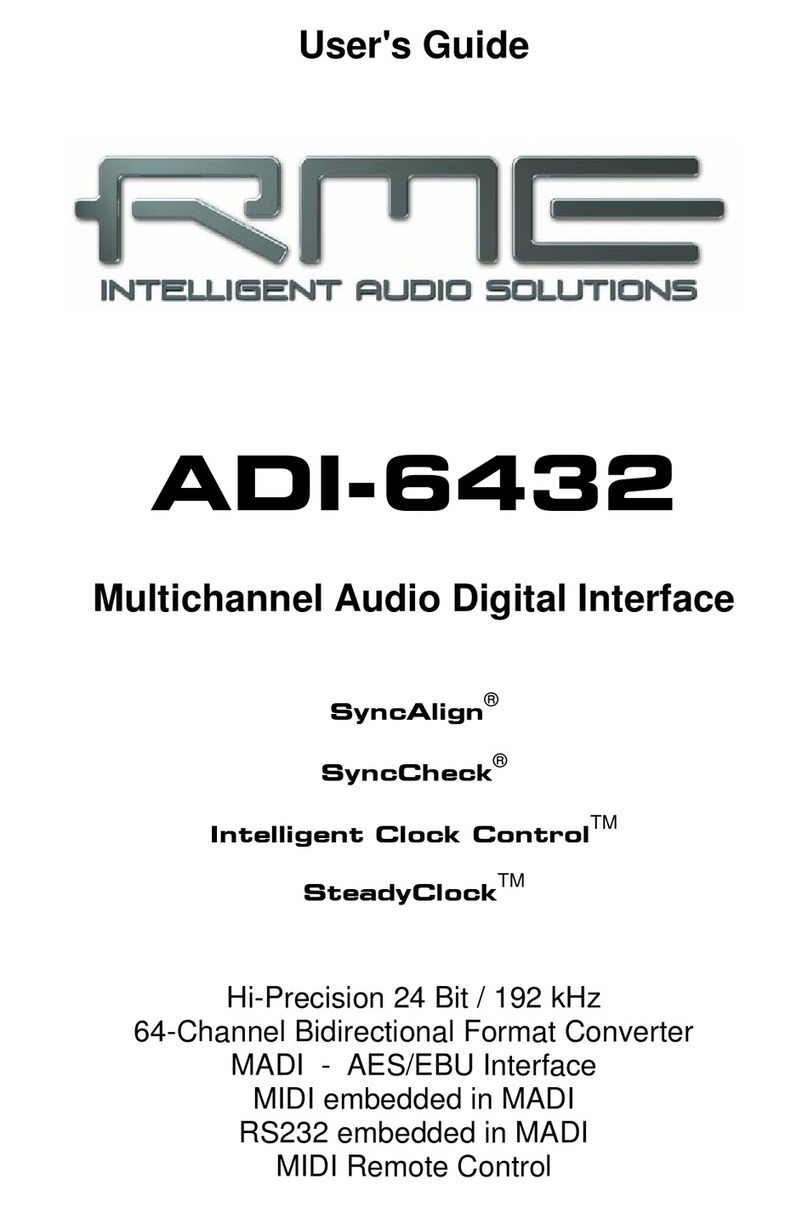
RME Audio
RME Audio ADI-6432 User manual

RME Audio
RME Audio Fireface 400 User manual
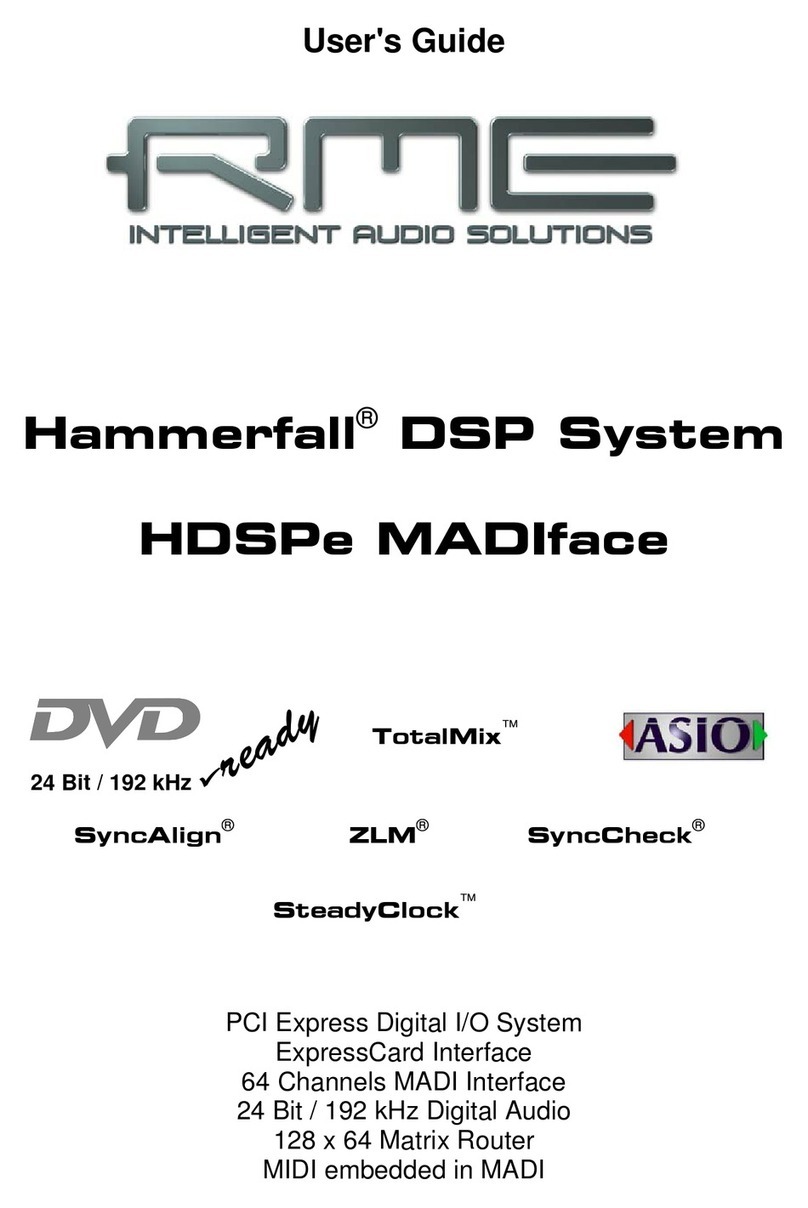
RME Audio
RME Audio Hammerfall HDSPe MADIface User manual
